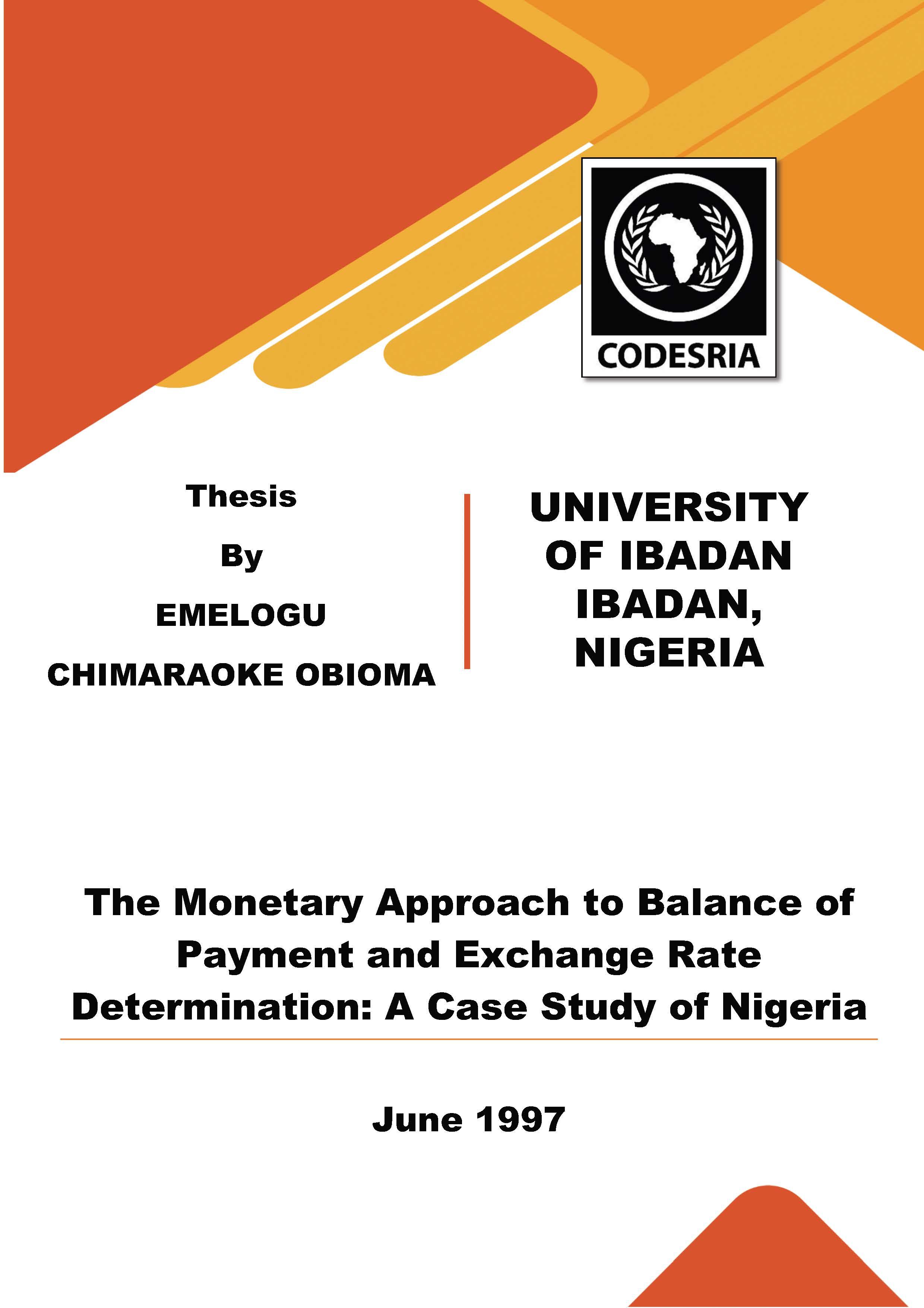The Monetary Approach to Balance of Payment and Exchange Rate Determination: A Case Study of Nigeria
Keywords:
Monetary Approach, Payment, Exchange, NigeriaSynopsis
The economic problems confronting developing countries like Nigeria have become issues of great concern in recent decades. Notable among these are the adverse balance of payments and exchange rate misalignment. These problems have been ascribed mainly to external shocks and inappropriate domestic macroeconomic policies. One of the attempts to tackle the problems \ led to renewed interest in the monetary approach to balance of payments and exchange rate determination. The monetary approach attributes balance of payments disequilibrium and exchange rate misalignment mainly to disequilibrium in the money market. This study endeavours, among other things, to empirically verify the proposition that balance of payments
disequilibrium and exchange rate misalignment are essentially a monetary phenomenon in a small open economy like Nigeria.
In the course of the study, single-equation econometric models based on the. monetary approach to balance of payments and exchange rate determination are estimated using the Ordinary Least Squares (OLS) regression technique. The empirical findings support most of the basic assumptions and postulates of the monetary approach during the period of fixed exchange
rate in Nigeria. The model significantly explains the movement of the balance of payments, measured by external reserve flow, during this period. However, there is only modest support for the monetary model in explaining exchange rate behaviour of the Nigerian currency (the naira) during the period of flexible exchange rate. Though an increase in domestic or relative money supply is found to depreciate the naira exchange rate on equiproportional basis during this period, as predicted by the monetary approach, other explanatory variables such as relative real income and interest rate differential are statistically insignificant and their coefficients often appear with wrong signs in the monetary model of exchange rate determination. The relatively poor performance of the monetary model of exchange rate determination in Nigeria is attributed to a number of factors, including frequent government intervention in the. foreign exchange market and the economic/political instability prevalent during the period under study.
On the basis of findings of the study, a number of"policy recommendations are-made. These include thd need for government to be cautious on policies or actions that tend to increase domestic credit and money stock since they are found to lead, with a reasonable degree of certainty, to adverse balance of payments and exchange rate depreciation. The study also suggests that the Central Bank of Nigeria should establish adequate mechanisms for proper coordination, harmonization and control of monetary and credit policy in the country in order to curtail excessive growth in domestic credit and money stock, and to ensure that the rate of monetary and credit expansion is consistent with the rates existing in the major trading partners.
This is a major requirement for the attainment of the current objectives of sustainable balance of payments and exchange rate stability. To meet this requriement, the Central Bank of Nigeria should be given adequate autonomy by the government. Given the evidence of significantly inherent tendency of exchange rate to depreciate during the period of floating exchange rates,
the study is of the view that government should continue with the present policy of guidedexchange rate deregulation, rather than leaving the market to entirely determine the exchange rate of the naira.
However, the relative! y poor performance of the monetary model of exchange rate determination suggests that one should look beyond the monetary model in order to adequately explain exchange rate behaviour in Nigeria.
Downloads
References
Macdonald R. and M. P. Taylor (1991), "The Monetary Approach to the Exchange Rate: Long-run Relationships and Coefficient Restrictions", Economics Letters, Vol. 37.
Macdonald R. and M. P. Taylor (1993), "The Monetary Approach to the Exchange Rate: Rational Expectations, Long-run Equilibrium, and Forecasting", IMF Staff Papers, Vol.40, No. 1 (March).
Marwah, Kanta (1969), "Measurement of Devaluation Impact: Indian Case Study", Indian Economic Journal, Vol. 17.
Meese, R. A. (1987), "Testing for Bubbles in Exchange Markets: A Case of Sparkling Bubbles", Journal of Political Economy, Vol. 94, No. 2: 345-373.
Meier, G. M. (1989), Leading Issues in Economic Development, (New York: Oxford).
Melvin, M. (1984), "Basic Theories of the Balance of Payments, Exchange Rates, and the Balance of Trade" Chapter 6 of International Money and Finance 90 - 111.
Montiel, P. J. and J. D. Ostry (1994), "The Parallel Market Premium", IMF Staff Papers, Vol,41, No.l, (March).
Mordi, C. N. 0. (1986), "Estimation of Demand/Supply Function of Bank Loans and Advances in Nigeria", Economic and Financial Review (Lagos: Central Bank of Nigeria, March).
Mordi, C. N. 0. and M. M. Audu (1991), "Constructing Effective Exchange Rate (EER) Indices: Methodological Issues and an Application to Nigeria", CBN's Economic and Financial Review, Vol. 29, No. 1, (June).
Mundell, R. A. (1968), International Economics, (New York: Macmillan).
Mussa, Michael (1974), "A Monetary Approach to Balance of Payments Analysis", Journal of Money, Credit and Banking: 333-357.
Mussa, Michael (1976), "Tariffs and the Balance of Payments: A Monetary Approach" in Frenkel, J. A. and H. G. Johnson, eds., The Monetary Approach to Balance of Payments, (London: Allen and Unwin).






